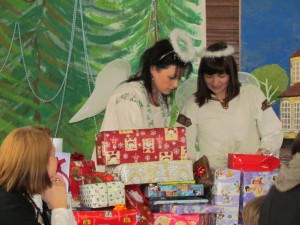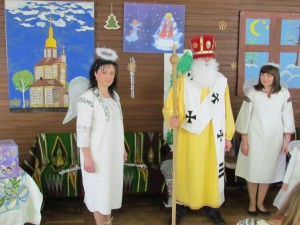Another 10 nights to go!
We often forget that some cultures have no Christmas. For others, such as many Orthodox Christians, Christmas is a particularly important holy day.
One example is the Ukraine. However, they celebrate Christmas on another day than we do. Consequently, the people there, of course, also have a totally different advent calendar and other rituals. Looking through today’s advent window at the Ukraine, we can learn when and how they celebrate Christmas.
But first: here are a few important data (source):
01.12 – Holy Roman’s Day
13.12 – Holy Andrew’s Day
19.12 – Saint Nicolas
 The story of Nicolas from Myra who cared for the poor and orphaned, is one we know all over the world. Two weeks before St. Nicolas Day, the children write letters to him.
The story of Nicolas from Myra who cared for the poor and orphaned, is one we know all over the world. Two weeks before St. Nicolas Day, the children write letters to him.
The children know that Saint Nicolas has a “book of good and evil deeds”. Consequently, he knows very well how every child behaved throughout the year.
So all the children very diligently write down all the good things they have done and make a sincere promise to learn even more and be even more obedient next year. Especially if they actually hope to get a present instead of the rod this year, after all.
On December, 18th, many schools, kindergardens and cultural centres organize a St. Nicolas party. The main element of each party is a theatre performance. The following story is played:
 St. Nicolas and the angels pack all the presents for those children who have been obedient. During the time, small devils try to get the children to stray from the good path. They instigate them to do stupid things, to not be industrious, to have arguments, to lie and the like. Or else, they try to switch the sack St. Nicolas is carrying for one full of evil character traits instead of presents.
St. Nicolas and the angels pack all the presents for those children who have been obedient. During the time, small devils try to get the children to stray from the good path. They instigate them to do stupid things, to not be industrious, to have arguments, to lie and the like. Or else, they try to switch the sack St. Nicolas is carrying for one full of evil character traits instead of presents.
The animals support the angels in their fight against the small devils. The children are told how they can behave differently and help others, thus following the good example of Saint Nicolas:
Feed birds and stray cats, show more respect towards the elderly, help other children with their homework or their parents at home, and much more.
After the performance, the children recite small poems or sing songs for Saint Nicolas. As a reward, they get presents at the end of the party.
 Many children firmly believe in Saint Nicolas. Until one day they see their parents as they wrap the presents. A week ago, I found a book on the internet. It is titled: ”Collection of letters for Saint Nicolas“. Some of the letters made me laugh. But one of them moved me deeply:
Many children firmly believe in Saint Nicolas. Until one day they see their parents as they wrap the presents. A week ago, I found a book on the internet. It is titled: ”Collection of letters for Saint Nicolas“. Some of the letters made me laugh. But one of them moved me deeply:
„Dear Saint Nicolas, I ask of you to bring peace to our country and kind-heartedness to our people. Thus, let it happen that my dad will finally get his pay. Please give my mother health and I wish for all people to be healthy, because this is the most valuable of all commodities. I would wish you to bring me a present I deserve. To be sure, I was not always obedient, but I tried not to make my mom unhappy. Hoping for your good-heartedness….“
On January, 6th, the day finally comes – Christmas Eve.
For the Ukrainians, Christmas is the most important family celebration and the most holy day of the entire year. Ukrainian Christmas customs are not exclusively based on Christian traditions. They are hugely influenced by pre-Christian and pagan culture and religion. The old pagan feasts, such as the winter solstice or the fertility festival have become part of the Christian Christmas rituals.
On Christmas Eve, the family gathers for dinner as soon as the first stars appear on the sky. The table is covered with two table-clothes. The first is for those members of the family who are dead, the second for the living family members.
Underneath the table, as well as under the table-clothes, a little hay is laid out. It is a reminder that Christ was born in a manger. There is always an additional set of cutlery laid out for the dead members of the family. It is believed that their souls return to the earth on Christmas Even in order to take part in the shared meal.
In the middle of the Christmas table, there is a Kolach (the Christmas bread). It is braided in the shape of a ring. Three such rings are put on top of each other. On top of those, in the middle of the ring, there is a candle. The three rings of bread symbolize the Holy Trinity, the round shape represents eternity.
A Didukh is a bundle of wheat or various corn stalks. It is lying underneath the house icons, symbolizing the ghosts of the forefathers. The Didukh is positioned on a favourite spot. Then the father or the oldest member of the family puts a bowl with Kutia next to it.
Kutia is cooked wheat porridge with poppy seeds, honey and ground walnuts. Kutia is the most important part of the Christmas Eve Dinner. A jar of Uzvar, that is a fruit mixture which should contain twelve different sorts of fruit, is positioned next to the Didukht bowl. In heathen times, Kutia and Didukht were what the Gods consumed.
When all these preparations are finished, the father says a prayer. After the prayer, he conveys all his best Christmas wishes to everybody by saying „Khrystos Razhdaietsia“ (Christ is born).
The Last Supper consists of twelve meat-free dishes. According to Christian tradition, each dish is dedicated to one of Christ’s apostles. In the old, heathen belief, each dish symbolizes the full moon as the year goes by. Besides the aforementioned Kutia and Uzvar, they also serve Borschtsch (beetroot soup) with Vushka (cooked pasta squares filled with fried champignons and onions), marinated herrings, sauerkraut, Varenyky (a little oversized Ravioli filled with booked potatoes) and Holubtsi (stuffed cabbage with buckwheat and ground potatoes).
Christmas is on January, 7th and January, 8th
Ukrainian Christmas Carols (Koliadky and Schedrivky) go back to ancient times. Both, Koliadky and Shchedrivky contain heathen elements that have been Christianized. For instance, one Koliadka tells the story of a farmer who was ordered to prepare by a swallow, because three guests are going to arrive: the sun, the moon and rain. In the Christianized vrsions, the three guests are Jesus Christ, Saint Nicolas and Saint George.
Ukrainian Christmas Carols are about various topics:
Happy celebration of Christ’s birth;
- Heathen and mythological ideas such as death in winter and new life in spring;
- Heroic and sad episodes of Ukrainian history;
- Glorification of the farmer and his family, as well as a praise of their work and their personal positive character traits.
Kolyadky is not just singing simple Christmas Carols. It is more like a traditional folk opera. The carollers first have to ask permission to sing. If the answer is yes, they may enter the house and sing a special song for each member of the family, even for the smallest children. - Sometimes, they also dance very slow, ritual dances. Once in a while, they will also present short and humorous parodies. In Ukrainian, that is called Vertep. In the Vertep, you will mostly hear anecdotes about the political situation or everyday life as a cabaret.
This beautiful report about the Ukrainian Advent Calendar was written and sent to my by one of our nice IF colleagues from Nuremberg, Roksana Oliynyk.
Dear Roksana: many thanks!
RMD
(Translated by EG)
P.S.
The pictures were taken on the Saint Nicolas Partyx of the Ukrainians in Franconia in 2010. Thanks again so much.

